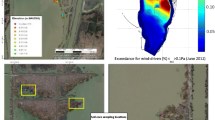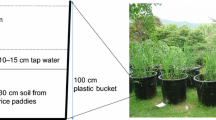Abstract
For wetland restoration success to be maximized, restoration managers need better information regarding how the frequency, depth, and duration of flooding affect soil chemistry and the survival, growth, and morphology of targeted plant species. In a greenhouse study we investigated the impact of four different flooding durations (0 %, 40 %, 60 %, and 100 %) on soil physicochemistry and the responses of seedlings and adults of two species of emergent wetland macrophytes commonly used in restoration efforts (Schoenoplectus acutus and Schoenoplectus californicus). The longest flooding duration, which created more reducing soil conditions, resulted in significantly reduced survival of S. acutus adults (34 ± 21 % survival) and complete mortality of seedlings of both species. Schoenoplectus californicus adults exhibited higher flooding tolerance, showing little impact of flooding on morphology and physiology. A companion field study indicated that S. californicus maintained stem strength regardless of flooding duration or depth, supporting the greenhouse study results. This information serves to improve our understanding of the ecological differences between these species as well as provide restoration managers with better guidelines for targeted elevation and hydrologic regimes for these species in order to enhance the success of restoration plantings and better predict restoration site development.






Similar content being viewed by others
References
Albert DA, Cox DT, Lemein T, Hyun-Doug Y (2013) Characterization of Schoenoplectus pungens in a great lakes coastal wetland and a Pacific northwestern estuary. Wetlands 33:445–458
Beatty RH (1964) Method for reducing lodging in small grains. United States Patent Office (3,314,777) Patented April 18, 1967
Blom CWPM, Voesenek LACJ (1996) Flooding: the survival strategies of plants. Tree 11:290–295
Bociąg K, Gałka A, Łazarewicz T, Szmeja J (2009) Mechanical strength of stems in aquatic macrophytes. Acta Soc Bot Pol 78:181–187
Boeger MR, Poulson ME (2003) Morphological adaptations and photosynthetic rates of amphibious Veronica anagalis-aquatica. L. under different flow regimes. Aquat Bot 75:123–135
Casanova MT, Brock MA (2000) How do depth, duration, and frequency of flooding influence the establishment of wetland plant communities? Plant Ecol 147:237–250
Crawford RMM (1982) Physiological responses to flooding. Physiological Plant Ecology II Encyclopedia of Plant Physiology 12:453–477
Dat JF, Capelli N, Folzer H, Bourgeade P, Badot P (2004) Sensing and signaling during plant flooding. Plant Physiol Biochem 42:273–282
DeLaune RD, Reddy KR (2005) Redox potential. Elsevier Ltd.
DeLaune RD, Smith CJ, Patrick WH (1983) Relationship of marsh elevation, redox potential, and sulfide to Spartina alterniflora productivity. Soil Sci Soc Am J 47:930–935
Eckert CG (1999) Clonal plant research: proliferation, integration, but not much evolution. Am J Bot 86:1649–1654
Elsey-Quirk T, Middleton BA, Proffitt CE (2009) Seed flotation and germination of salt marsh plants: the effects of stratification, salinity, and/or inundation regime. Aquat Bot 91:40–46
Galinato MI, van der Valk AG (1986) Seed germination traits of annuals and emergents recruited during drawdowns in the delta marsh, Manitoba, Canada. Aquat Bot 28:89–102
Harper JL (1977) Population biology of plants. Academic Press, London
Hester MW, Willis JM, Sloey TM (2015) Field assessment of environmental factors constraining the development and expansion of Schoenoplectus californicus marsh at a California tidal freshwater restoration site. Wetlands Ecology and Management(in review)
Jackson MB, Armstrong W (1999) Formation of aerenchyma and the processes of plant ventilation in relation to soil flooding and submergence. Plant Biol 1:274–287
Jones R, Etherington JR (1971) Comparative studies of plant growth and distribution in relation to waterlogging. J Ecol 59:793–801
Kramer PJ (1951) Causes of injury to plants resulting from flooding of the soil. Plant Physiol 26:722–736
Mandak B, Pysek P (2001) The effects of light quality, nitrate concentration and presence of bracteoles on germination of different fruit types in the heterocarpous Atriplex sagittata. J Ecol 89:149–158
McKee KL, Patrick WH (1988) The relationship of smooth cordgrass (Spartina alterniflora) to tidaldatums: a review. Estuaries 11:143–151
Messina MG, Conner WH (1998) Southern forested wetlands. CRC Press LLC, Boca Raton, Florida
Middleton BA (1999) Wetland restoration, flood pulsing, and disturbance dynamics. Wiley & Sons, Inc, Hoboken, New Jersey
Mitsch WJ, Gosselink JG (2007) Wetlands, Fourth edn. John Wiley and Sons, Hoboken, New Jersey, USA
Sartoris GB, Belcher BA (1949) The effect of flooding on flowering and survival of sugar cane. Sugar 44:36–39
SAS Institute, Inc (2010) Enterprise Guide 4.2 On Demand. SAS Institute, Inc., Cary, North Carolina
Simenstad CA, Thom RM (1996) Functional equivalency trajectories of the restored Gog-Le-Hi-Te estuarine wetland. Ecol Appl 6:38–56
Sloey TS, Willis JM, Hester MW (2015) Hydrologic and edaphic constraints on S. acutus, S. californicus, and T. latifolia in tidal marsh restoration. Restoration Ecology (accepted March 2015)
Sorrell BK, Mendelssohn IA, McKee KL, Woods RA (2000) Ecophysiology of wetland plant roots: a modeling comparison of aeration in relation to species distribution. Ann Bot 86:675–685
Spink A, Rogers S (1996) The effects of a record flood on the aquatic vegetation of the upper Mississippi river system: some preliminary findings. Hydrobiologia 340:51–57
Tanner CC (2001) Growth and nutrient dynamics of soft-stem bulrush in constructed wetlands treating nutrient-rich wastewaters. Wetl Ecol Manag 9:49–73
Tiner RW (1999) Wetland indicators: a guide to wetland identification, delineation, classification, and mapping. CRC Press LLC, Boca Raton, Florida
United States Department of Agriculture/ Natural Resources Conservation Service (2014) Plant guide. Interagency Riparian/Wetland Project, Plant Materials Center, Aberdeen, Idaho
USDA/NRCS (United States Dept. of Agriculture/ Natural Resources Conservation Services (2012) Plants Database. www.plants.usda.gov
Van Bodegom PM, Sorrell BK, Oosthoek A, Bakker C, Aerts R (2008) Separating the effects of partial submergence and soil oxygen demand on plant physiology. Ecology 89:193–204
Vervuren PJA, Blom CWPM, de Kroon H (2003) Extreme flooding events on the Rhine and the survival and distribution of riparian plant species. J Ecol 91:135–146
Voesnek LACJ, Rijnders JGM, Peeters AJM, van de Steeg HM, de Kroon H (2004) Plant hormones regulate fast shoot elongation under water: from genes to communities. Ecology 85:16–27
Watson EB, Byrne R (2009) Abundance and diversity of tidal marsh plants along the salinity gradient of the San Francisco estuary: implications for global change ecology. Plant Ecol 205:113–128
Weiher E, Keddy PA (1995) The assembly of experimental wetland plant communities. Oikos 73:323–335
Whigham DF (1999) Ecological issues related to wetland preservation, restoration, creation and assessment. The Science of the Total Environment 240:31–40
Wijte AHB, Gallagher J (1996) Effects of oxygen availability and salinity on early life history stages of salt marsh plants. I. Difference germination strategies of Spartina alterniflora and Phragmites australis (Poaceae). Am J Bot 83:1337–1342
Williams PB, Orr MK (2002) Physical evolution of restored breached levee salt marshes in the San Francisco bay estuary. Restor Ecol 10:527–542
Zedler JB (1997) Restoring tidal wetlands: a scientific view. National Wetlands News 19:8–11
Acknowledgments
Funding for this study was partially provided by the Society of Wetland Scientists’ student research grant program. Our sincere thanks is extended to members of the Coastal Plant Ecology Laboratory at the University of Louisiana at Lafayette, the National Wetlands Research Center in Lafayette, LA, and Drs. Dennis Albert and Dan Cox of Oregon State University.
Additionally, we thank Drs. Scott France, Paul Leberg, and Beth Middleton for comments and manuscript review. Any use of trade, firm, or product names is for descriptive purposes only and does not imply endorsement by the U.S. Government.
Author information
Authors and Affiliations
Corresponding author
Electronic supplementary material
ESM 1
(DOCX 27 kb)
Rights and permissions
About this article
Cite this article
Sloey, T.M., Howard, R.J. & Hester, M.W. Response of Schoenoplectus acutus and Schoenoplectus californicus at Different Life-History Stages to Hydrologic Regime. Wetlands 36, 37–46 (2016). https://doi.org/10.1007/s13157-015-0713-8
Received:
Accepted:
Published:
Issue Date:
DOI: https://doi.org/10.1007/s13157-015-0713-8




